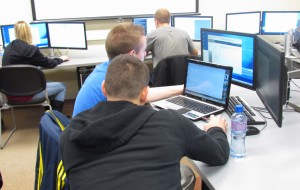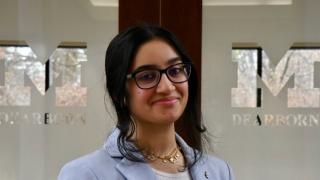
“There is a great need for a quick, reliable and accurate authentication of digital information,” said Hafiz Malik, assistant professor of electrical and computer engineering. “Law enforcement agencies, as well as the private sector, need trained professionals to work in the area of digital forensics, as analysts and expert witnesses.”
Malik began teaching digital forensics in 2010—a course jointly offered by the Department of Electrical and Computer Engineering and the Department of Computer and Information Science—and CIS announced a digital forensics major last winter.
Digital forensics requires hands-on skills, therefore, reading assignments and in-class discussions can only do so much to prepare students for digital forensics careers.
“We needed a lab for hands-on learning to give students the experience of using the systems,” Malik said.
Now, with the digital forensics lab in place, Malik teaches students basics of digital forensics such as evidence acquisition, how to analyze evidence (or images) for information including: Where are the files? What was deleted? Where did they go after deletion? Who created a given file? What is the timeline of activities of the file?
Tracking evidence has developed from the days of following the paper trails. Investigators now follow the digital trail. Or, in many cases, they analyze the editing trail.
Students pore over information in the lab, working to put together the pieces of the puzzle. It’s the exact type of work professionals are doing in the field, Malik says.
The lab is equipped with 14 dual-monitor terminals. Students use EnCase—the preferred software in the industry and law enforcement communities. Students also learn how to use the Sleuth Kit & Autopsy, an open source forensics analysis tool.
The new lab comes at a time when interest in the field of digital forensics is growing.
“I’m interested in the overall field of digital forensics,” said computer engineering student Mark Waterbury. “It’s been rising in popularity; different law enforcement agencies are seeing a greater need for skills in digital forensics.”
Malik agrees, saying, “Just a few years ago there were only a few universities offering programs in digital forensics, but now many universities have started offering programs in this area. Having this lab with the latest technology is a good start as the program grows.”




